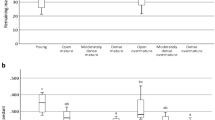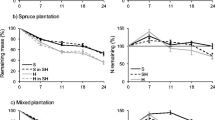Abstract
This study investigated the effects of Ips typographus (L.) damage on initial litter quality parameters and subsequent decomposition rates of oriental spruce tree species [Picea orientalis (L.) Link]. The needle litter was collected from highly damaged, moderately damaged and control stands on two aspects (north and south) and two slope position (top and bottom) on each aspect. The litter was analyzed for initial total carbon, lignin and nutrient (nitrogen, phosphorus, potassium, calcium, magnesium and manganese) concentrations. The variability in nitrogen and calcium concentrations and ratios of C:N, lignin:N and lignin:Ca was significantly affected by the insect damaged levels. While nitrogen concentrations in needle litter increased with increasing insect damage (and consequently the ratios of C:N and lignin:N decreased), calcium concentrations decreased (and consequently the ratio of lignin:Ca increased). Aspect and slope positions explained most of the variability in carbon, lignin, phosphorus, potassium, magnesium and manganese concentrations and lignin:P ratio between all studied stands. Litter decomposition was studied in the field using the litterbag technique. The litter from highly damaged stands showed highest decomposition rates followed by moderately damaged and control stands. The mass loss rates were significantly positively correlated with initial nitrogen concentration and negatively with C:N and lignin:N ratios. The effects of microclimate resulting from canopy damage on litter decomposition was also examined at the same time using standard litter with the same litter quality parameters, but they showed no significant differences among the insect damage levels indicating that alteration of the litter quality parameters produced by I. typographus damage played a more important role than altered microclimate in controlling needle litter decomposition rates. However, changes in microclimate factors due to topography influenced decomposition rates.


Similar content being viewed by others
References
Aber JD, Melillo JM, McClaugherty CA (1990) Predicting long term pattern of mass loss, nitrogen dynamics and soil organic matter formation from fine litter chemistry in temperate forest ecosystems. Can J Bot 68:2201–2269. doi:10.1139/b90-287
Aerts R (1997) Climate, leaf litter chemistry and leaf litter decomposition in terrestrial ecosystems: a triangular relationship. Oikos 79:439–449. doi:10.2307/3546886
Aerts R, Chapin FSIII (2000) The mineral nutrition of wild plantsrevisited: a re-evaluation of processes and patterns. Adv Ecol Res 30:1–67
Allen SE (1989) Chemical analysis of ecological materials. Blackwell Scientific Publications, Oxford
Barnes BV, Zak DR, Denton SR, Spurr SH (1998) Forest ecology, 4th edn. Wiley, New York
Bauhus J, Pare D, Cote L (1998) Effects of tree species, stand age and soil type on soil microbial biomass and its activity in a southern boreal forest. Soil Biol Biochem 30:1077–1098. doi:10.1016/S0038-0717(97)00213-7
Berg B, Meentemeyer V (2002) Litter quality in European transect versus carbon storage potential. Plant Soil 242:83–92. doi:10.1023/A:1019637807021
Berg B, Berg M, Bottner P, Box E, Breymeyer A, Calvo de Anta R et al (1993) Litter mass loss rates in pine forests of Europe and Eastern United States: some relationships with climate and litter quality. Biogeochemistry 20:127–159. doi:10.1007/BF00000785
Berg B, Calvo de Anta R, Escudero A, Gardenas A, Johansson M-B, Laskowski R et al (1995) The chemical composition of newly shed needle litter of Scots pine and some other pine species in a climatic transect. X. Long term decomposition in a Scots pine forest. Can J Bot 73:1423–1435. doi:10.1139/b95-406
Chapman SK (2006) Herbivory differentially alters plant litter dynamics of evergreen and deciduous trees. Oikos 114:566–574. doi:10.1111/j.2006.0030-1299.14676.x
Chapman SK, Hart SC, Cobb NS, Whitham TG, Koch GW (2003) Insect herbivory increases litter quality and decomposition: an extension of the acceleration hypothesis. Ecology 84:2867–2876. doi:10.1890/02-0046
Classen AT, Hart SC, Whitman TG, Cobb NS, Koch GW (2005) Insect ınfesttations linked to shift in microclimate: Important climate change implications. Soil Sci Soc Am J 69:2049–2057. doi:10.2136/sssaj2004.0396
Cobb RC, Orwig DA, Currie S (2006) Decomposition of green foliage in eastern hemlock forests of southern New England impacted by hemlock woolly adelgid infestations. Can J Res 36:1331–1341. doi:10.1139/X06-012
Couteaux MM, Bottner P, Berg B (1995) Litter decomposition, climate and litter quality. Trends Ecol Evol 10:63–66. doi:10.1016/S0169-5347(00)88978-8
Cox P, Wilkinson SP, Anderson JM (2001) Effects of fungal inocula on the decomposition of lignin and structural polysaccharides in Pinus sylvestris litter. Biol Fertil Soils 33:246–251. doi:10.1007/s003740000315
De Santo AV, Berg B, Rutigliano FA, Aleani A, Fioretto A (1993) Factors regulating early stage decomposition of needle litter in five different coniferous forests. Soil Biol Biochem 25:1423–1433. doi:10.1016/0038-0717(93)90057-I
Enoki T, Kawaguchi H, Iwatsubo G (1997) Nutrient-uptake and use efficiency of Pinus thunbergii Parl. along a topographical gradient of soil nutrient availability. Ecol Res 12:191–199. doi:10.1007/BF02523784
Erbek FS, Ölmez Z, Uça Avcı ZD (2005) Artvin yöresi ladin (Picea orientalis L. Link) orman alanlarında böcek zararlıları nedeniyle oluşan tahribatın izlenmesinde uydu görüntülerinin kullanımı. Ladin Sempozyumu Bildiriler Kitabı-I, 20–22 Ekim, s. 222–232, Trabzon
Fierer N, Craine JM, McLauchlan K, Schimel JP (2005) Litter quality and the temperature sensitivity of decomposition. Ecology 86:320–326. doi:10.1890/04-1254
Findlay S, Carreiro M, Krischick V et al (1996) Effects of damage to living plants on leaf litter quality. Ecol Appl 6:269–275. doi:10.2307/2269570
Fioretto A, Musacchio A, Andolfi G, de Santo AV (1998) Decomposition dynamics of litter of various pine species in a Corsican pine forest. Soil Biol Biochem 30:721–727. doi:10.1016/S0038-0717(97)00182-X
Gülçür F (1974) Toprağın Fiziksel ve kimyasal Analiz Metodları (Physical and chemical analyzing methods of soil properties. IU. F Orman Fakültesi Yayın No: 201, İstanbul, Turkey
Heal OW, Anderson JM, Swift MJ (1997) Plant litter quality and decomposition: an historical overview. In: Cadisch G, Giller KE (eds) Driven by nature: plant litter quality and decomposition. CAB International Wallingford, UK, pp 3–45
Hunter MD (2001) Insect population dynamics meets ecosystem ecology: effects of herbivory on soil nutrient dynamics. Agric For Entomol 3:77–84. doi:10.1046/j.1461-9563.2001.00100.x
Kalra YP, Maynard DG (1991) Methods manual for forest soil and plant analysis. forestry Canada. Northern Forestry Publications, Alberta
Karban R, Baldwin IT (1997) Induced responses to herbivory. University of Chicago Press, Chicago
Kurz-Besson C, Couteaux MM, Berg B, Remacle J, Ribeiro C, Romanya J et al (2006) A climate response function explaining most of the variation of the forest floor needle mass and the needle decomposition in pine forest across Europe. Plant Soil 285:97–114. doi:10.1007/s11104-006-0061-9
Liski J, Nissinen A, Erhard M, Taskinen O (2003) Climatic effects on litter decomposition from arctic tundra to tropical rainforest. Glob Change Biol 9:575–584. doi:10.1046/j.1365-2486.2003.00605.x
Mattson WJ (1980) Herbivory in relation to plant nitrogen content. Annu Rev Ecol Syst 11:119–161. doi:10.1146/annurev.es.11.110180.001003
Met Office (2000) DMİ Artvin and Borçka Meteorology Stations, Artvin
Neely CL, Beare MH, Hargrove W, Coleman DC (1991) Relationships between fungal and bacterial substrate-induced respiration, biomass and plant residue decomposition. Soil Biol Biochem 23:947–954. doi:10.1016/0038-0717(91)90175-J
Nelson DW, Sommers LE (1982) Total carbon, organic carbon and organic matter. In: Page AL, Miller RH, Keeney DR (eds) Methods of soil analysis. American Society of Agronomy, Madison, pp 539–579
Nykanen H, Koricheva J (2004) Damge-induced changes in woody plants and their effects on insect herbivore performance: a meta-analysis. Oikos 104:132–139. doi:10.1111/j.0030-1299.2004.12768.x
Olson JS (1963) Energy storage and the balance of producers and decomposers in ecological systems. Ecology 14:322–331. doi:10.2307/1932179
Pontious J, Hallett R, Martin M (2002) Examining the role of foliar chemistry in hemlock wolly adelgid infestation and hemloch decline. In: Onken B, Reardon J, Lashomb NJ (eds) Proceedings of the symposium on the hemlock woolly adelgid in the Eastern United States, East Brunswick, NJ, 5–7 Feb 2002. Ag. Exp. Sta. Rutgers University, East Brunswick, pp 86–99
Prescott CE (1996) Influence of forest floor type on rates of litter decomposition in microcosms. Soil Biol Biochem 28:1319–1325. doi:10.1016/S0038-0717(96)00132-0
Rollet B (1990) Leaf morphology. In: Rollet B, Hogermann Ch, Roth I (eds) Stratification of tropical forests as seen in leaf structure, Part 2. Kluwer, Dordrecht
Rowland AP, Roberts JD (1994) Lignin and cellulose fractionation in decomposition studies using acid-detergent fibre methods. Commun Soil Sci Plant Anal 25:269–277
Sariyildiz T, Anderson JM (2003a) Interactions between litter quality, decomposition and soil fertility: a laboratory study. Soil Biol Biochem 35:391–399. doi:10.1016/S0038-0717(02)00290-0
Sariyildiz T, Anderson JM (2003b) Decomposition of sun and shade leaves from three deciduous tree species, as affected by their chemical composition. Biol Fertil Soils 37:137–146
Sariyildiz T, Anderson JM (2005) Variation in the chemical composition of green leaves and leaf litters from three deciduous tree species growing on different soil types. For Ecol Manage 210:303–319
Sariyildiz T, Anderson JM, Kucuk M (2005) Effects of tree species and topography on soil chemistry, litter quality and decomposition in Northeast Turkey. Soil Biol Biochem 37:1695–1706. doi:10.1016/j.soilbio.2005.02.004
Schowalter TD (2000) Insect ecology: an ecosystem approach. Academic Press, San Diego
Schowalter TD, Hargrove WW, Crossley DA (1986) Herbivory in forested ecosystems. Annu Rev Entomol 31:177–196. doi:10.1146/annurev.en.31.010186.001141
Stadler WT, Muller T, Orwig DA, Cobb RC (2005) Hemlock woolly adelgid: canopy impacts transforming ecosystem processes and landscapes. Ecosystems (N. Y., Print) 8:233–247. doi:10.1007/s10021-003-0092-5
Swift MJ, Heal OW, Anderson JM (1979) Decomposition in terrestrial ecosystems. Blackwell Scientific Publications, Oxford
Vitousek PM, Turner DR, Parton WJ, Sandford RL (1994) Litter decomposition on the Mauna Loa environmental matrix, Hawaii: Patterns, mechanisms and models. Ecology 75:418–429. doi:10.2307/1939545
Wermelinger B (2004) Ecology and management of the spruce bark beetle Ips typographus— a review of recent research. For Ecol Manage 202:67–82
Wessman CA, Abert JD, Peterson DL, Melillo JM (1988) Remote sensing of canopy chemistry and nitrogen cycling in temperate forest ecosystems. Nature 335:154–156. doi:10.1038/335154a0
Zak DR, Pregitzer KS, Curtis PS, Teeri JA, Fogel R, Randlett DL (1993) Elevated atmospheric CO2 and feedback between carbon and nitrogen cycles. Plant Soil 151:105–117. doi:10.1007/BF00010791
Acknowledgments
This research was funded by The Scientific and Technological Research Council of Turkey (TUBITAK) with the project number 106O193. The authors would like to thank Artvin Forestry Commission for permission to collect plant litter and soil samples, and to carry out the litter decomposition experiments in the Hatila Valley National Park in Artvin, Turkey. We are also grateful for the helpful comments from the reviewers and subject editor in the revision of this paper.
Author information
Authors and Affiliations
Corresponding author
Additional information
Communicated by A. Merino.
Rights and permissions
About this article
Cite this article
Sariyildiz, T., Akkuzu, E., Küçük, M. et al. Effects of Ips typographus (L.) damage on litter quality and decomposition rates of Oriental Spruce [Picea Orientalis (L.) Link.] in Hatila Valley National Park, Turkey. Eur J Forest Res 127, 429–440 (2008). https://doi.org/10.1007/s10342-008-0226-6
Received:
Revised:
Accepted:
Published:
Issue Date:
DOI: https://doi.org/10.1007/s10342-008-0226-6




